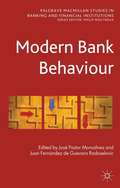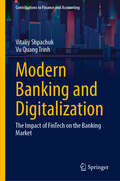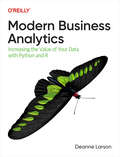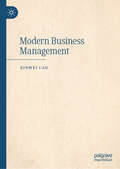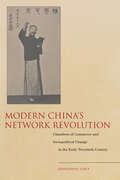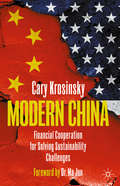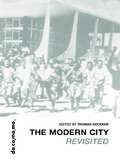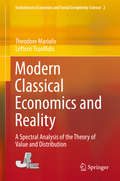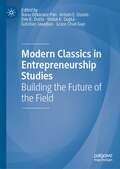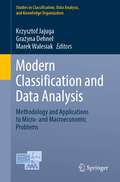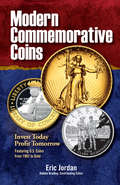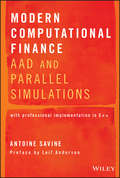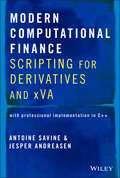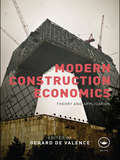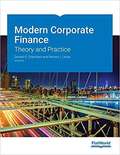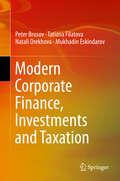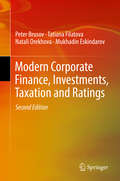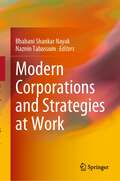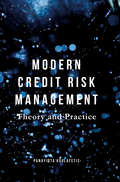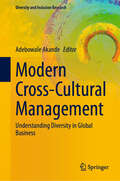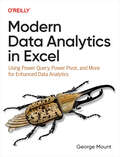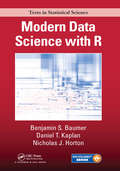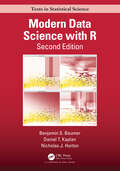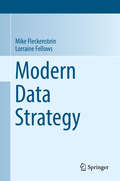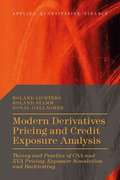- Table View
- List View
Modern Bank Behaviour (Palgrave Macmillan Studies in Banking and Financial Institutions)
by Juan Fernández de Guevara Radoselovics José Manuel Pastor MonsálvezUpdated insight into key facts impacting on financial institutions after the financial crisis, highlighting areas of major policy and academic interest. The book includes ten chapters analysing contrasting issues such as intellectual capital, cost efficiency, bank stability, credit risk and business models for the wealth management industry.
Modern Banking and Digitalization: The Impact of FinTech on the Banking Market (Contributions to Finance and Accounting)
by Vu Quang Trinh Vitaliy ShpachukThis book provides a comprehensive overview of the evolving dynamics in modern banking, emphasizing how digitalization and optimization are reshaping operational frameworks, fundamentally altering institutional structures, and introducing new risks and opportunities. These transformative changes are anticipated to significantly impact the competitive landscape of the financial market. By exploring the primary trends and characteristics shaping the future of banking activities and institutions, this book offers crucial insights for bank owners and founders as they formulate strategic guidelines for their operations, as well as for bank managers in their current activities.
Modern Business Analytics: Increasing the Value of Your Data with Python and R
by Deanne LarsonDeriving business value from analytics is a challenging process. Turning data into information requires a business analyst who is adept at multiple technologies including databases, programming tools, and commercial analytics tools. This practical guide shows programmers who understand analysis concepts how to build the skills necessary to achieve business value.Author Deanne Larson, data science practitioner and academic, helps you bridge the technical and business worlds to meet these requirements. You'll focus on developing these skills with R and Python using real-world examples. You'll also learn how to leverage methodologies for successful delivery. Learning methodology combined with open source tools is key to delivering successful business analytics and value.This book shows you how to:Apply business analytics methodologies to achieve successful resultsCleanse and transform data using R and PythonUse R and Python to complete exploratory data analysisCreate predictive models to solve business problems in R and PythonUse Python, R, and business analytics tools to handle large volumes of dataCommit code to GitHub to collaborate with data engineers and data scientistsMeasure success in business analytics
Modern Business Management
by Xinwei CaoThis book explores the evolving dynamics of market competition in an age defined by rapid technological advancements and globalization. Drawing from interdisciplinary research across evolutionary theory, economics, computer science, and biology, it provides strategies for businesses, both large and small, to thrive in fiercely competitive environments. This book will interest scholars, businesspeople and economists.
Modern China's Network Revolution
by Zhongping ChenChambers of commerce developed in China as a key part of its sociopolitical changes. In 1902, the first Chinese chamber of commerce appeared in Shanghai. By the time the Qing dynasty ended, over 1,000 general chambers, affiliated chambers, and branch chambers had been established throughout China. In this new work, author Zhongping Chen examines Chinese chambers of commerce and their network development across Lower Yangzi cities and towns, as well as the nationwide arena. He details how they achieved increasing integration, and how their collective actions deeply influenced nationalistic, reformist, and revolutionary movements. His use of network analysis reveals how these chambers promoted social integration beyond the bourgeoisie and other elites, and helped bring society and the state into broader and more complicated interactions than existing theories of civil society and public sphere suggest. With both historical narrative and theoretical analysis of the long neglected local chamber networks, this study offers a keen historical understanding of the interaction of Chinese society, business, and politics in the early twentieth century. It also provides new knowledge produced from network theory within the humanities and social sciences.
Modern China: Financial Cooperation for Solving Sustainability Challenges
by Cary KrosinskyCalling for more cooperation between China and the west, this new book by noted author and educator Cary Krosinsky provides readers with an on-the-ground perspective of what’s really happening in China today on the back of its recent economic rise, its desire and need to solve environmental challenges and the new positive dynamic created by its need for foreign capital. In doing so, Krosinsky and his colleagues from the Sustainable Finance Institute and Brown University highlight how China has recaptured its role as a leader in innovation, arguing that current approaches to the relationship hinder global progress on issues such as climate change, inequality, air pollution, food integrity and water security and pushes back on confrontational approaches and attempts to clarify misperceptions about contemporary China. China’s recent rise includes becoming a global leader on green policy and green finance, as it is increasingly leading the way towards modernization through innovation strategies focused on infrastructure, education, healthcare and aspects of clean energy technology, leading to opportunities across private equity, venture capital and green bonds. This creates an exciting opportunity for positive change, with environmental challenges becoming more salient to its own population, adding pressure on the government to provide solutions. China changes faster than any country in the world, creating an opportunity for meaningful, ongoing, positive transitions. Modern China is a call for more cooperation, and makes a clear, cogent case for collaboration in the face of current confrontational approaches. At the same time, dire environmental and social circumstances require an all-hands-on-deck approach. This book provides specific examples of what’s working and what’s needed to compete and thrive in this new paradigm through trusted relationships placed front and center for the future of economies and the betterment of global society.
Modern City Revisited
by Thomas DeckkerThe supposed rationality of the urban planning of the Modern Movement encompassed a variety of attitudes towards history, technology and culture, from the vision of Berlin as an American metropolis, through the dispute between the urbanists and disurbanists in the Soviet Union to the technocratic and austere vision of Le Corbusier. After the Second World War, architects attempted to reconcile these utopian visions to the practical problems of constructing - or reconstructing - urban environments, from Piero Bottoni at the Quartiere Trienale 8 in Milan in 1951 to Lucio Costa at Bras'lia in 1957. In the 1970s, the collapse of Modernism brought about universial condemnation of Modern urbanism; urban planning,and rationality itself, were thrown into doubt. However, such a wholesale condemnation hides the complex realities underlying these Modern cities. The contributors define some of the theoretical foundations of Modern urban planning, and reassess the successes and the failures of the built results. The book ends with contrasting views of the inheritance of Modern urbanism in the United States and the Netherlands.
Modern Classical Economics and Reality
by Lefteris Tsoulfidis Theodore MariolisThis book presents an in-depth, novel, and mathematically rigorous treatment of the modern classical theory of value based on the spectral analysis of the price-profit-wage rate system. The classical theory is also subjected to empirical testing to show its logical consistency and explanatory content with respect to observed phenomena and key economic policy issues related to various multiplier processes. In this context, there is an examination of the trajectories of relative prices when the distributive variables change, both theoretically and empirically, using actual input-output data from a number of quite divers e economies. It is suggested that the actual economies do not behave like the parable of a one-commodity world of the traditional neoclassical theory, which theorizes the relative scarcities of "goods and production factors" as the fundamental determinants of relative prices and their movement. By contrast, the results of the empirical analysis are fully consistent with the modern classical theory, which makes the intersectoral structure of production and the way in which net output is distributed amongst its claimants the fundamental determinants of price magnitudes. At the same time, however, these results indicate that only a few vertically integrated industries ("industry core" or "hyper-basic industries") are enough to shape the behaviour of the entire economy in the case of a disturbance. This fact is reduced to the skew distribution of the eigenvalues of the matrices of vertically integrated technical coefficients and reveals that, across countries and over time, the effective dimensions of actual economies are surprisingly low. Normal 0 false false false EN-US JA X-NONE />
Modern Classics in Entrepreneurship Studies: Building the Future of the Field
by Golshan Javadian Vishal K. Gupta Dev K. Dutta Grace Chun Guo Arturo E. Osorio Banu Ozkazanc-PanThe purpose of this book is to identify and analyze modern classics in entrepreneurship research with the goal of highlighting cutting-edge themes in the work of various scholars that are pushing the boundaries of the field, post 2000. As the entrepreneurship field matures, it is important to identify the novel contributions that will help shape the next decades of scholarship, by providing scholars with the concepts, frameworks, and approaches needed to help develop the new theories and practices of entrepreneurship. By focusing on emerging key contributions, this book takes a stance that sets it apart from other similar works by scholars that have focused only on existing themes rather than those that will characterize the relationship between entrepreneurship and new technological advances, growing inequalities, gender, diversity and inclusion, and socio-political shifts in the landscape of entrepreneurial ecosystems, allowing for critical and new conversations on entrepreneurship to take shape. This book will provide discussion on emergent themes and approaches that will continue to build the future of entrepreneurship as an exciting and rigorous academic discipline.
Modern Classification and Data Analysis: Methodology and Applications to Micro- and Macroeconomic Problems (Studies in Classification, Data Analysis, and Knowledge Organization)
by Krzysztof Jajuga Marek Walesiak Grażyna DehnelThis volume presents a selection of peer-reviewed papers that address the latest developments in the methodology and applications of data analysis and classification tools to micro- and macroeconomic problems. The contributions were originally presented at the 30th Conference of the Section on Classification and Data Analysis of the Polish Statistical Association, SKAD 2021, held online in Poznań, Poland, September 8–10, 2021. Providing a balance between methodological and empirical studies, and covering a wide range of topics, the book is divided into five parts focusing on methods and applications in finance, economics, social issues and to COVID-19 data. The book is aimed at a wide audience, including researchers at universities and research institutions, PhD students, as well as practitioners, data scientists and employees in public statistical institutions.
Modern Commemorative Coins: Invest Today - Profit Tomorrow
by Eric JordanModern commemoratives and American Eagles are the answer for today's collector who wants to make a secure investment without spending thousands of dollars. New issues from the U.S. Mint struck in silver, gold and platinum have great potential for investment growth, if you key in on low mintage strikes. Modern Commemorative Coins will show you how to: • Include modern coins in your self-directed IRA • Include numismatic investments as part of your estate plan • Select coins that have the best chance of increasing in value Take the next step beyond collecting State quarters and Presidential dollars to the exciting world of rare modern coins. Collect coins that combine beauty with tangible assets to create family heirlooms.
Modern Computational Finance: AAD and Parallel Simulations
by Antoine Savine Leif AndersenArguably the strongest addition to numerical finance of the past decade, Algorithmic Adjoint Differentiation (AAD) is the technology implemented in modern financial software to produce thousands of accurate risk sensitivities, within seconds, on light hardware.AAD recently became a centerpiece of modern financial systems and a key skill for all quantitative analysts, developers, risk professionals or anyone involved with derivatives. It is increasingly taught in Masters and PhD programs in finance.Danske Bank's wide scale implementation of AAD in its production and regulatory systems won the In-House System of the Year 2015 Risk award. The Modern Computational Finance books, written by three of the very people who designed Danske Bank's systems, offer a unique insight into the modern implementation of financial models. The volumes combine financial modelling, mathematics and programming to resolve real life financial problems and produce effective derivatives software.This volume is a complete, self-contained learning reference for AAD, and its application in finance. AAD is explained in deep detail throughout chapters that gently lead readers from the theoretical foundations to the most delicate areas of an efficient implementation, such as memory management, parallel implementation and acceleration with expression templates.The book comes with professional source code in C++, including an efficient, up to date implementation of AAD and a generic parallel simulation library. Modern C++, high performance parallel programming and interfacing C++ with Excel are also covered. The book builds the code step-by-step, while the code illustrates the concepts and notions developed in the book.
Modern Computational Finance: Scripting for Derivatives and xVA
by Antoine Savine Jesper AndreasenAn incisive and essential guide to building a complete system for derivative scripting In Volume 2 of Modern Computational Finance Scripting for Derivatives and xVA, quantitative finance experts and practitioners Drs. Antoine Savine and Jesper Andreasen deliver an indispensable and insightful roadmap to the interrogation, aggregation, and manipulation of cash-flows in a variety of ways. The book demonstrates how to facilitate portfolio-wide risk assessment and regulatory calculations (like xVA). Complete with a professional scripting library written in modern C++, this stand-alone volume walks readers through the construction of a comprehensive risk and valuation tool. This essential book also offers: Effective strategies for improving scripting libraries, from basic examples—like support for dates and vectors—to advanced improvements, including American Monte Carlo techniques Exploration of the concepts of fuzzy logic and risk sensitivities, including support for smoothing and condition domains Discussion of the application of scripting to xVA, complete with a full treatment of branching Perfect for quantitative analysts, risk professionals, system developers, derivatives traders, and financial analysts, Modern Computational Finance Scripting for Derivatives and xVA: Volume 2 is also a must-read resource for students and teachers in master’s and PhD finance programs.
Modern Construction Economics: Theory and Application
by Gerard De ValenceTraditional building economics has primarily been concerned with issues around project appraisal and cost management techniques. On the other hand, modern construction economics has a wider focus with stronger links to mainstream economics, reflecting an increased interest in a range of theoretical issues in construction economics, both at the macro and micro level. In Modern Construction Economics: Theory and Application, a variety of approaches are used to present a coherent vision of synthesis between industry economics and project economics. Topics covered include: developing construction economics as idustry economics competition and barriers to entry in construction innovation in construction theory testing in construction management research collusion and corruption in the construction sector. Including contributions from academics in the UK, Sweden, Hong Kong, and Australia, this is a truly global review of a core issue for the construction industry worldwide. The result is a unique book that will push toward the development of a comprehensive theoretical framework of construction economics. This is a must-read for all serious students of construction economics, and all practitioners looking for a deeper understanding of their industry.
Modern Corporate Finance Version 8.0
by Donald R. Chambers Nelson J. LaceyWhen purchased from FlatWorld (the publisher), this Color Print Textbook includes Online Access, Quizzes, Flashcards and Homework (if professor uses Homework system). Online textbook is accessible. Modern Corporate Finance combines a forward-looking vision of corporate finance with the tried and true practices of the past. With a clear and concise approach, the authors emphasize the modernist movement in finance, which is based on systematic methodology with an emphasis on deductive reasoning and empirical validation.
Modern Corporate Finance, Investments and Taxation
by Peter Brusov Tatiana Filatova Natali Orekhova Mukhadin EskindarovThis monograph is devoted to the modern theory of capital cost and capital structure and its application to the real economy. In particular, it presents a possible explanation to the causes of global financial crisis. The authors of the book modify the theory of Nobel Prize winners Modigliani and Miller to describe an alternative theory of capital cost and capital structure that can be applied to corporations with arbitrary lifetime and investment projects with arbitrary duration. The authors illustrate their theory with examples from corporate practice and develop investment models that can be applied by companies in their financial operations.
Modern Corporate Finance, Investments, Taxation and Ratings
by Peter Brusov Tatiana Filatova Natali Orekhova Mukhadin EskindarovThis monograph is devoted to a modern theory of capital cost and capital structure created by this book’s authors, called the Brusov–Filatova–Orekhova (BFO) theory, and its application to the real economy. BFO theory promises to replace the traditional theory of capital cost and capital structure by Nobel laureates Modigliani and Miller. This new theory in particular, presents a possible explanation to the causes of the recent global financial crisis. The authors of the book describe the general theory of capital cost and capital structure that can be applied to corporations of arbitrary age (or with arbitrary lifetime) and investment projects with arbitrary duration. The authors illustrate their theory with examples from corporate practice and develop investment models that can be applied by companies in their financial operations.This updated second edition includes new chapters devoted to the application of the BFO theory in ratings, banking and other areas. The authors also provide a new approach to rating methodology highlighting the need for including financial flow discounting, the incorporation of rating parameters (in particular, financial ratios) into the modern theory of capital structure - BFO theory. This book aims to change our understanding of corporate finance, investments, taxation and rating procedures. The authors emphasize that the most used principles of financial management should be changed in accordance to BFO theory.
Modern Corporations and Strategies at Work
by Bhabani Shankar Nayak Naznin TabassumStrategies are integral to growth, expansion and sustainability of modern corporations. The agile strategies are central to overcome challenges of the turbulent times accelerated by risks, pandemics, wars, political instabilities and environmental disasters. This book on ‘Modern Corporations and Strategies at Work’ focuses on different strategies followed by corporations. This book makes critical reading of corporate strategies and evaluates them. This book offers insights into the way corporations develop and implement strategies to face different challenges. This book explores wider world of corporate strategies and their limitations. The future of world economy and international business is shaped by large modern corporations and their rapidly changing business, management and marketing strategies. This book explores the way modern nation states are standing behind the corporations to ensure that their strategies are successful in a world of complex challenges. This book further examines how collaborations between the state and modern corporations are part of the corporate strategy at work today. Further how modern strategies are integral to the start, growth, expansion and sustainability of modern corporations. This book explores operational agilities and organisational abilities of modern corporations to engage with diverse challenges and overcome the crisis. The volatile business environment is creating conditions of instabilities for the market to function effectively and efficiently. Such conditions are weakening all agents and structures operating within international business and world economy. This book argues that there is an urgent need for a profound reshaping of the corporate strategies to deal with a post pandemic society. It is perhaps as far reaching as that the remaking of corporate strategies are in the crossroads today due to its intrinsic profit motives. The remaking of modern corporate strategy comes in the wake of pestilence of a global health crisis; its full impacts are yet to be felt, evaluated and understood. A comprehensive shift in corporate strategy from formulation, implementation and evaluation to remaking is at the heart of this transformations in the working of the corporations and their fundamental ideological apparatus.
Modern Credit Risk Management
by Panayiota KoulafetisThis book is a practical guide to the latest risk management tools and techniques applied in the market to assess and manage credit risks at bank, sovereign, corporate and structured finance level. It strongly advocates the importance of sound credit risk management and how this can be achieved with prudent origination, credit risk policies, approval process, setting of meaningful limits and underwriting criteria. The book discusses the various quantitative techniques used to assess and manage credit risk, including methods to estimate default probabilities, credit value at risk approaches and credit exposure analysis. Basel I, II and III are covered, as are the true meaning of credit ratings, how these are assigned, their limitations, the drivers of downgrades and upgrades, and how credit ratings should be used in practise is explained. Modern Credit Risk Management not only discusses credit risk from a quantitative angle but further explains how important the qualitative and legal assessment is. Credit risk transfer and mitigation techniques and tools are explained, as are netting, ISDA master agreements, centralised counterparty clearing, margin collateral, overcollateralization, covenants and events of default. Credit derivatives are also explained, as are Total Return Swaps (TRS), Credit Linked Notes (CLN) and Credit Default Swaps (CDS). Furthermore, the author discusses what we have learned from the financial crisis of 2007 and sovereign crisis of 2010 and how credit risk management has evolved. Finally the book examines the new regulatory environment, looking beyond Basel to the European Union (EU) Capital Requirements Regulation and Directive (CRR-CRD) IV, the Dodd-Frank Wall Street Reform and Consumer Protection Act. This book is a fully up to date resource for credit risk practitioners and academics everywhere, outlining the latest best practices and providing both quantitative and qualitative insights. It will prove a must-have reference for the field.
Modern Cross-Cultural Management: Understanding Diversity in Global Business (Diversity and Inclusion Research)
by Adebowale AkandeThis book addresses the profound changes brought by digital technologies. Virtual teams, cloud-based collaboration, and real-time communication have eliminated geographical boundaries, creating a hyperconnected world where cultural nuances blend seamlessly. This book further examines the relationship between culture and effective leadership, highlighting the challenges of managing diverse teams in our interconnected era. It redefines the understanding of management within the social sciences, emphasizing the development of cultural competencies to build and sustain unified teams, and focusing on leveraging knowledge, honing judgment, evaluating performance, and preparing individuals for leadership positions. Incorporating perspectives from renowned scholars such as Edgar Schein, House, Triandis, Bass, Hofstede, and others, the book discusses often neglected topics. It covers essential skills for the global business landscape and analyzes the beliefs, values, work behaviors, communication styles, and business practices that differ across cultures. By examining the perceptions of natives and foreigners and adaptable managerial strategies for various settings, the book supports leaders with efficient strategies for success. Focusing on developing effective leadership, the chapters include topics such as: global leadership competencies, building cross-cultural teams during disruptive times, impactful communication, strategic decision-making, managing transitions, embracing diversity, and the dynamics between leaders and followers. The book is written in accessible language and provides real-world examples, offering a novel perspective on leadership in an increasingly diverse world. It is a must-read for anyone interested in a better understanding of modern cross-cultural management against today's turbulent political and economic climates and will appeal to global business professionals, academics, practitioners, students, and management researchers from diverse fields, in both the humanities and business sectors.
Modern Data Analytics in Excel: Using Power Query, Power Pivot, and More for Enhanced Data Analytics
by George MountIf you haven't modernized your data cleaning and reporting processes in Microsoft Excel, you're missing out on big productivity gains. And if you're looking to conduct rigorous data analysis, more can be done in Excel than you think. This practical book serves as an introduction to the modern Excel suite of features along with other powerful tools for analytics.George Mount of Stringfest Analytics shows business analysts, data analysts, and business intelligence specialists how to make bigger gains right from your spreadsheets by using Excel's latest features. You'll learn how to build repeatable data cleaning workflows with Power Query, and design relational data models straight from your workbook with Power Pivot. You'll also explore other exciting new features for analytics, such as dynamic array functions, AI-powered insights, and Python integration.Learn how to build reports and analyses that were previously difficult or impossible to do in Excel. This book shows you how to:Build repeatable data cleaning processes for Excel with Power QueryCreate relational data models and analysis measures with Power PivotPull data quickly with dynamic arraysUse AI to uncover patterns and trends from inside ExcelIntegrate Python functionality with Excel for automated analysis and reporting
Modern Data Science with R (Chapman & Hall/CRC Texts in Statistical Science)
by Benjamin S. Baumer Daniel T. Kaplan Nicholas J. HortonModern Data Science with R is a comprehensive data science textbook for undergraduates that incorporates statistical and computational thinking to solve real-world problems with data. Rather than focus exclusively on case studies or programming syntax, this book illustrates how statistical programming in the state-of-the-art R/RStudio computing environment can be leveraged to extract meaningful information from a variety of data in the service of addressing compelling statistical questions. <P><P> Contemporary data science requires a tight integration of knowledge from statistics, computer science, mathematics, and a domain of application. This book will help readers with some background in statistics and modest prior experience with coding develop and practice the appropriate skills to tackle complex data science projects. The book features a number of exercises and has a flexible organization conducive to teaching a variety of semester courses.
Modern Data Science with R (Chapman & Hall/CRC Texts in Statistical Science)
by Benjamin S. Baumer Daniel T. Kaplan Nicholas J. HortonFrom a review of the first edition: "Modern Data Science with R… is rich with examples and is guided by a strong narrative voice. What’s more, it presents an organizing framework that makes a convincing argument that data science is a course distinct from applied statistics" (The American Statistician).Modern Data Science with R is a comprehensive data science textbook for undergraduates that incorporates statistical and computational thinking to solve real-world data problems. Rather than focus exclusively on case studies or programming syntax, this book illustrates how statistical programming in the state-of-the-art R/RStudio computing environment can be leveraged to extract meaningful information from a variety of data in the service of addressing compelling questions.The second edition is updated to reflect the growing influence of the tidyverse set of packages. All code in the book has been revised and styled to be more readable and easier to understand. New functionality from packages like sf, purrr, tidymodels, and tidytext is now integrated into the text. All chapters have been revised, and several have been split, re-organized, or re-imagined to meet the shifting landscape of best practice.
Modern Data Strategy
by Mike Fleckenstein Lorraine FellowsThis book contains practical steps business users can take to implement data management in a number of ways, including data governance, data architecture, master data management, business intelligence, and others. It defines data strategy, and covers chapters that illustrate how to align a data strategy with the business strategy, a discussion on valuing data as an asset, the evolution of data management, and who should oversee a data strategy. This provides the user with a good understanding of what a data strategy is and its limits. Critical to a data strategy is the incorporation of one or more data management domains. Chapters on key data management domains—data governance, data architecture, master data management and analytics, offer the user a practical approach to data management execution within a data strategy. The intent is to enable the user to identify how execution on one or more data management domains can help solve business issues. This book is intended for business users who work with data, who need to manage one or more aspects of the organization’s data, and who want to foster an integrated approach for how enterprise data is managed. This book is also an excellent reference for students studying computer science and business management or simply for someone who has been tasked with starting or improving existing data management.
Modern Derivatives Pricing and Credit Exposure Analysis: Theory and Practice of CSA And XVA Pricing, Exposure Simulation and Backtesting (Applied Quantitative Finance)
by Roland Stamm Roland Lichters Donal GallagherThis book provides a comprehensive guide for modern derivatives pricing and credit analysis. Written to provide sound theoretical detail but practical implication, it provides readers with everything they need to know to price modern financial derivatives and analyze the credit exposure of a financial instrument in today's markets.
